CSA : Confederate States Army.
Mark weapons delivered "officially" by the regular troops Southerners during the American Civil War.
CSA MARKS ON BELGIAN PINFIRE GUNS
The use of Liège-made pinfire revolvers by Confederate soldiers during the Civil War
One can hear and read several legends about the use of Liège-made pinfire revolvers by the Confederate troops during the American Civil War. Some even do believe that the Liège industry of arms making has produced and exported thousands of pinfire revolvers of all calibres and patterns to the United States in those days.
Historic truth is however quite different. Although it is true that Liège-made pinfire guns found their way to Confederate hands during that war, and notwithstanding the very few and fragmented reports on that subject, one can assume that the total number of these guns does not exceed a few hundreds, maybe a few thousands.
Exact figures of purchases of European guns by the Confederates, through the Union blockade and during the whole war, are unknown. Yet on basis of fragmented information’s left by the Confederate administration, one can rate the total number of individual arms bought in Europe as being approximately 350,000, among which 250,000 revolvers of British, French, Spanish and Belgian origin.
Those guns were bought in London by Captain Caleb Huse, who had been entitled by the Confederate government to buy all individual weapons he could find and forward them to the Confederacy.
The export to the US of such an amount of weapons, together with tons of ammunition, by the five blockade breakers owned by the Confederacy, was an almost unachievable task.
In comparison, the records left by the Union army mention the import of only 11.833 pinfire revolvers from Europe during the war. These guns were all of the French Lefaucheux model 1854 pattern.
Only one "Belgian" contract is known to have been signed by the Union: Alexis Godillot, gunmaker at Paris and Liège, was contracted by the Union government for the delivery of 2,000 revolvers of the Lefaucheux 1854 pattern. Only 1,500 of these guns were delivered, the remaining 500 appear to have been lost in a ship break during a storm. A subsequent delivery of 600 guns was rejected for unknown reasons.
The amount of guns within that contract that could have been produced at Liège is probably very small, for at the side of the Liège unmaking industry there are no traces of any mass production effort during that period (1861).
This is easy to understand considering the organisation of business in the Liège unmaking industry of the era. Based on a huge number of small home-working gunmakers, the mass production of one single model, identical in all respects and of equal quality, was simply impossible to achieve.
The French Lefaucheux 1854 model, in the 12 mm calibre, was preferred by both sides, and that is the one that can be seen on the most tintypes of the time. Yet on the Confederate side, the great lack of firearms leads also to the use of 9 mm and even a few 7 mm calibres as well. In very small numbers, however, for the distribution of proper ammunition for these guns was also a problem.
Northerners
Southerners
Captain Caleb Huse purchased all the 12 mm pinfire revolvers he could find, but dealed only with a large British gun importer, the London Armoury Company. Records of the company show the sale of 80,000 Enfield rifles and 9,000 Kerr percussion revolvers to Huse in 1863; yet details about other weapons sold to Huse have been lost.
No records can be found on the side of the carriers either, for as they were considered as rebels and illegal, the masters of the five Confederacy-owned blockade-breakers did not register many details of their cargoes on their ship's manifests. They indicated simply as "hardware" or "civilian merchandise" on these documents.
The Confederacy even imported unfinished guns, as can be proven by a crate found in 1974 in Texas, and which contained unfinished parts for several
9 mm pinfire revolvers. These guns could have been produced at Liège, but this is impossible to confirm as they bear no marks at all. They could also have been made by
C.D. Leet & Co of Springfield, who was the sole known American gunmaker to have produced pinfire revolvers, or by other European makers.
CSA Marks
Considering the chaotic administrative and military situation the Confederacy was facing, it can easily be understood that the marking of individual weapons was not regarded as a priority. Unlike what was currently done in the Union army, only very few revolvers used by the Confederates were effectively stamped with the letters C.S. or C.S.A. Even among the estimated 10,000 percussion Colt Navy and Whitney copies made by the Confederate gunmakers on behalf of their government, only a few numbers bear these stamps.
The marks were stamped either in the units that were using the guns or in far more seldom cases individually by the soldiers themselves. Usually the letters are stamped with separated dies for each letter and each dot, frequently not in a proper alignment. They are simple capital letters, and exist in two different sizes. They can be found either on the frame, the top of the chamber, or the cylinder.
Even scarcer are the engraved CSA markings, which are individual and private acts only.
At least one 1854 Lefaucheux is known that appears to have been used in both armies. The gun is confederate-stamped CSA 9 VA, but its serial number (between 25.000 and 37.000) proves undoubtedly it was one of the 11,833 guns purchased by the Union. So that gun could have been captured from a Union soldier and reissued to the Confederate unit 9 VA (9th Virginia) after having been marked.
Experts all concur to say that at first glance, ALL C.S.A. markings found on pinfire revolvers should be considered spurious, for a simple reason: after the Appomattox surrender, the Union army was overloaded with a tremendous overstock of handguns, which were sold to large dealers like Bannermann or Schuyler. A small part of these arms returned to Europe, but most appeared quite difficult to sell, for they were still on the catalogs in 1910.
It has also been established that in the 1950's, when collectors began to look after Civil War memorabilia, many of those unscrupulous dealers had the markings CSA stamped or engraved on all pinfire guns they could find, in order to increase their value from $ 2.5 up to $ 7.5 a piece.
However, as they were unaware of the proper European and specially Liège markings, they faked a great number of revolvers that can now be found bearing the pre-1893 ELG in an oval and also the post-1877 controller's stamp with star, together with CSA markings...
Those fakes have made all CSA markings spurious for ever, and some experts even say that you can only be sure that marks are original if you have seen with your own eyes a Confederate soldier stamp them on the gun.
So if you happen to find a Liège-made pinfire gun marked CS or CSA, do not rush anything. There are 99 pct chances the gun has been faked. On the contrary, a 12 mm pinfire bearing only contemporary Belgian proofmarks, without any specific American markings, could have been used in the Civil War and sent back to Europe afterwards. Only God and the gun could tell...
The "Chimney Adaptor"
As they often ran out of the proper pinfire ammunition during the war, the Confederate had solved the problem by inventing the "chimney adaptor". The adaptor is a metallic shell, closed at the rear end and fitted with a percussion nipple instead of a pin. The original pinfire notches in the cylinder chambers were slightly enlarged to allow the nipple to pass through, and the shells were simply placed into the chambers, so that the gun could be loaded with caps and balls like any other percussion arm.
The ejector rod was used as a rammer to seat the balls in place, and the adaptors could easily been removed to load proper pinfire ammunition when available.
The problems with that system were numerous, for the thin iron ejector rod cannot hold the force necessary to seat the ball home, and bends easily. Besides, its place on the gun imposes the loading right in front of the loading gate, which is a weak point on pinfire revolvers.
Breaking or loosing the loading gate renders the gun unserviceable, for pinfire cartridges have a smaller diameter than that of the chambers, so they can easily slide out and prevent the cylinder from rotating.
Many unlucky Confederate soldiers have experienced that problem and probably lost their lives.
On the other hand, however, guns found back without loading gate, with bent ejector rods and sometimes still fitted with chimney adaptors or with enlarged notches, allow today's collectors to identify them more effectively.
Marcel
The tintypes show Confederate and Union soldiers armed with pinfire revolvers.
Example of marks CSA
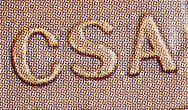
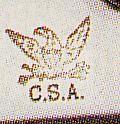
False !
Another weapon marked CSA
Photos of "COLLECTORSFIREARMS"
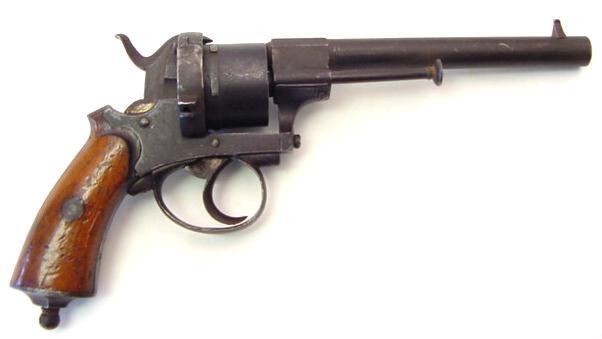
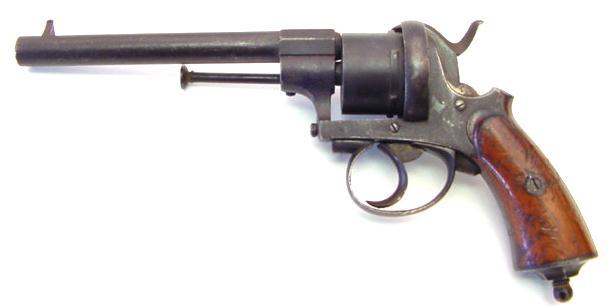
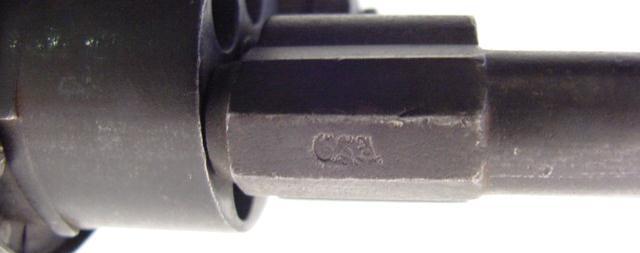
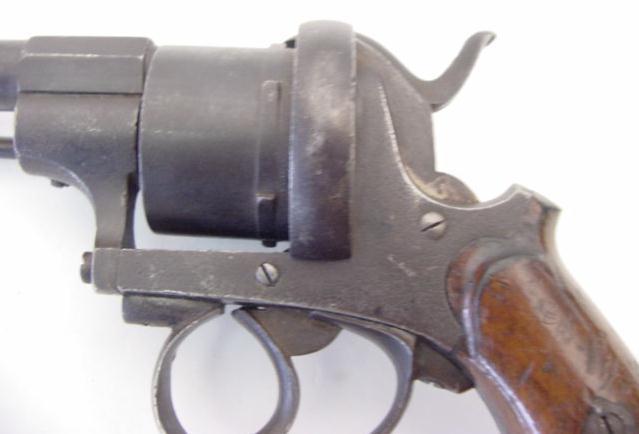

A revolver of Liège which one is absolutely sure that it was used for Confédérés. Gauge 12 mm, engraved, offered by its soldiers to the General Southerner Jackson "Stonewall".
Marcel
